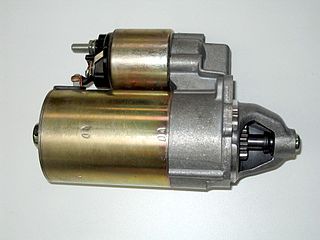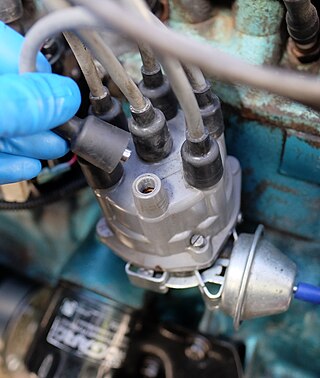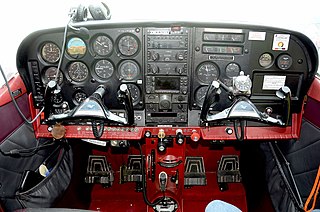
A starter is a device used to rotate (crank) an internal-combustion engine so as to initiate the engine's operation under its own power. Starters can be electric, pneumatic, or hydraulic. The starter can also be another internal-combustion engine in the case, for instance, of very large engines, or diesel engines in agricultural or excavation applications.

A vehicle start-stop system or stop-start system automatically shuts down and restarts the internal combustion engine to reduce the amount of time the engine spends idling, thereby reducing fuel consumption and emissions. This is most advantageous for vehicles that spend significant amounts of time waiting at traffic lights or frequently come to a stop in traffic jams. Start-stop technology may become more common with more stringent government fuel economy and emissions regulations. This feature is present in hybrid electric vehicles, but has also appeared in vehicles that lack a hybrid electric powertrain. For non-electric vehicles, fuel economy gains from this technology are typically in the range of 3–10%, potentially as high as 12%. In the United States, according to the Department of Energy, idling wastes more than 6 billion U.S. gallons of fuel per year.

Ignition systems are used by heat engines to initiate combustion by igniting the fuel-air mixture. In a spark ignition versions of the internal combustion engine, the ignition system creates a spark to ignite the fuel-air mixture just before each combustion stroke. Gas turbine engines and rocket engines normally use an ignition system only during start-up.

Aircraft engine controls provide a means for the pilot to control and monitor the operation of the aircraft's powerplant. This article describes controls used with a basic internal-combustion engine driving a propeller. Some optional or more advanced configurations are described at the end of the article. Jet turbine engines use different operating principles and have their own sets of controls and sensors.

Automobile accessory power can be transferred by several different means. However, it is always ultimately derived from the automobile's internal combustion engine, battery, or other "prime mover" source of energy. The advent of high-powered batteries in hybrid and all-electrical vehicles is shifting the balance of technologies even further in the direction of electrically powered accessories.

Engine braking occurs when the retarding forces within an internal combustion engine are used to slow down a motor vehicle, as opposed to using additional external braking mechanisms such as friction brakes or magnetic brakes.

The Ford Model T used a 177 cu in (2.9 L) sidevalve, reverse-flow cylinder head inline 4-cylinder engine. It was primarily a gasoline engine. It produced 20 hp (14.9 kW) for a top speed of 45 mph (72 km/h). It was built in-unit with the Model T's novel transmission, sharing the same lubricating oil.

A tell-tale, sometimes called an idiot light or warning light, is an indicator of malfunction or operation of a system, indicated by a binary (on/off) illuminated light, symbol or text legend.

The Honda Express or Honda NC50 is a scooter made by Honda between 1977 and 1983. Variants include the Express (NC50), Express II (NA50), Express SR (NX50) and Urban Express (NU50). All versions of the Express line are powered by an air-cooled 49 cc (3.0 cu in) two-stroke engine.
The following items are commonly used automotive acronyms and abbreviations:

A model engine is a small internal combustion engine typically used to power a radio-controlled aircraft, radio-controlled car, radio-controlled boat, free flight, control line aircraft, or ground-running tether car model.
The following outline is provided as an overview of and topical guide to automobiles:
The DiesOtto motor is an experimental automobile engine that "is said to incorporate the benefits of a diesel engine, but runs on gasoline instead."
Automotive electronics are electronic systems used in vehicles, including engine management, ignition, radio, carputers, telematics, in-car entertainment systems, and others. Ignition, engine and transmission electronics are also found in trucks, motorcycles, off-road vehicles, and other internal combustion powered machinery such as forklifts, tractors and excavators. Related elements for control of relevant electrical systems are also found on hybrid vehicles and electric cars.
Internal combustion engines come in a wide variety of types, but have certain family resemblances, and thus share many common types of components.

A small engine is the general term for a wide range of small-displacement, low-powered internal combustion engines used to power lawn mowers, generators, concrete mixers and many other machines that require independent power sources. These engines often have simple designs, for example an air-cooled single-cylinder petrol engine with a pull-cord starter, capacitor discharge ignition and a gravity-fed carburetor.

An internal combustion engine is a heat engine in which the combustion of a fuel occurs with an oxidizer in a combustion chamber that is an integral part of the working fluid flow circuit. In an internal combustion engine, the expansion of the high-temperature and high-pressure gases produced by combustion applies direct force to some component of the engine. The force is typically applied to pistons, turbine blades, a rotor, or a nozzle. This force moves the component over a distance. This process transforms chemical energy into kinetic energy which is used to propel, move or power whatever the engine is attached to.

Car controls are the components in automobiles and other powered road vehicles, such as trucks and buses, used for driving and parking.
The Startix automatic engine starting mechanism was a relay in a small box added to the vehicle's electrical system. It automatically started an engine from cold or if stalled. It was supplied to vehicle manufacturers in the mid 1930s and later as an aftermarket accessory — in the USA by Bendix Aviation Corporation Eclipse Machine Division and in UK by Joseph Lucas & Son both of which businesses made electric self-starters. Such devices are now part of the engine management systems which switch off and on to conserve fuel.














